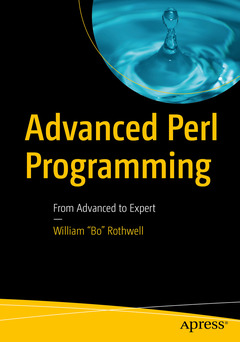Chapter One Command Line Options
1.1 Introducing Command Line Options
1.2 Changing Input Record Separator
1.3 Create a Loop Around Your Script
1.4 Editing in Place
1.5 Syntax Checking
1.6 Pre-appending to @INC
1.7 Including Modules
1.8 Command Line Parsing
1.9 Displaying Configuration Information
1.10 Extracting Scripts from Messages
1.11 Additional Resources
1.12 Lab Exercises
Chapter Two References
2.1 What are References?
2.2 Creating References
2.3 Returning the Value from a Reference
2.4 The ref Function
2.5 Making Anonymous References
2.6 References to Functions
2.7 use strict ‘refs’
2.8 Additional Resources
2.9 Lab Exercises
Chapter Three Advanced Data Types: Arrays
3.1 Review: What You Should Already Know About Arrays
3.2 What You Might Know About Arrays
3.3 Arrays of Arrays
3.4 Creating Arrays of Arrays
3.5 Accessing Values in an Array of Arrays
3.6 Adding a Sub Array (Row)
3.7 Adding a column
3.8 Printing an Array of Arrays
3.9 Additional Resources
3.10 Lab Exercises
Chapter Four Advanced Data Types: Hashes
4.1 Review: What You Should Already Know About Hashes
4.2 What You Might Know About Hashes
4.3 Hashes of Hashes
4.4 Creating Hashes of Hashes
4.5 Accessing Values in a Hash of Hashes
4.6 Other Data Structures
4.7 Additional Resources
4.8 Lab Exercises
Chapter Five Typeglobs
5.1 Symbolic Tables
5.2 Typeglobs
5.3 Using typeglobs
5.4 References vs. Typeglobs
5.5 Avoiding Aliases to Entire Identifier
5.6 Making constants
5.7 Passing Filehandles into Functions
5.8 Redefining a Function
5.9 Temporarily Redefining a Function
5.10 Additional Resources
5.11 Lab Exercises
Chapter Six Advanced Subroutine Handling
6.1 Review: What You Should Already Know About Functions
6.2 What You Might Know About Functions
6.3 Making Persistent Function Variables
6.4 Using the caller Function
6.5 Passing Arguments by Reference
6.6 Determining Functions Return Data
6.7 Returning Multiple Values
6.8 Exception Handling
6.9 Constant Functions
6.10 Prototypes
6.11 Additional Resources
6.12 Lab Exercises
Chapter Seven Packages and Namespaces
7.1 Scope
7.2 Creating Namespaces with the package Command
7.3 Fully Qualified Package Names
7.4 Nested Packages
7.5 use strict 'vars'
7.6 Identifiers Not Affected by Packages
7.7 Determine the Current Package
7.8 Packages vs. my Variables
7.9 Additional Resources
7.10 Lab Exercises
Chapter Eight Building Modules
8.1 Introduction to Perl Modules
8.2 Creating a Module
8.3 BEGIN and END Blocks
8.4 Symbol Tables in Modules
8.5 Exporting Identifiers from Modules
8.6 Private Identifiers
8.7 Oking Symbols to Export from Modules
8.8 Module Version Numbers
8.9 use vs. require
8.10 A Note About Library Files
8.11 Additional Resources
8.12 Lab Exercises
Chapter Nine Installing CPAN Modules
9.1 What is CPAN?
9.2 Accessing CPAN
9.3 CPAN Organization
9.4 Installing a CPAN Module Manually
9.5 Installing CPAN Modules Using the CPAN Module
9.6 Using the Perl Package Manager to Install CPAN Modules
9.7 Listing What Modules are Currently Installed
9.8 Additional Resources
9.9 Lab Exercises
Chapter Ten POD
10.1 Overview of POD
10.2 POD Commands
10.3 POD Text
10.4 POD Verbatim
10.5 POD Examples
10.6 Common POD Problems
10.7 POD Utilities
10.8 Additional Resources
10.9 Lab Exercises
Chapter Eleven Advanced Features
11.1 Perl development environments
11.2 The power of the do statement
11.3 autodie
11.4 String variables as files
11.5 File::Spec
11.6 Proper use of soft references
11.7 Install modules from CPAN without admin privileges
11.8 Basic testing
11.9 Advanced testing
11.10 Using prove
11.11 Benchmarking
Chapter Twelve Advanced Data Structures
12.1 Introduction to Benchmarking
12.2 Use the Readonly module to create constants
12.3 Make large numbers more readable
12.4 Make use of Scalar::Util
12.5 Make use of List::Util
12.6 Make use of List::MoreUtils
12.7 List formatting
12.8 Understand slices
12.9 Make use of Hash::Util
12.10 Make use of Hash::MoreUtils
12.11 Smart use of subscripts
12.12 Understand the advantages and disadvantages of for, foreach, grep and map
12.13 Know different sort techniques
12.14 Avoid using memory to store large data
Chapter Thirteen New Features
12.1 Perl versions
12.2 The latest/greatest?
12.3 Changes by version
12.4 The feature pragma
12.5 Make use of the Smartmatch Operator
12.6 The // operator
12.7 The UNITCHECK block
12.8 Yada yada
12.9 The autodie pragma
12.10 Using each, keys, values with arrays
12.11 New Regular Expression modifiers
12.12 Non-destructive substation
12.13 Automating Regular Expression modifiers
12.14 New feature for given
12.15 Change in use feature
12.16 The CORE namespace
12.17 Overriding Perl keywords




